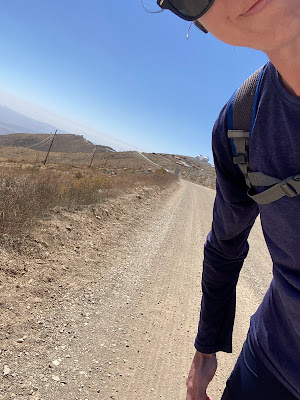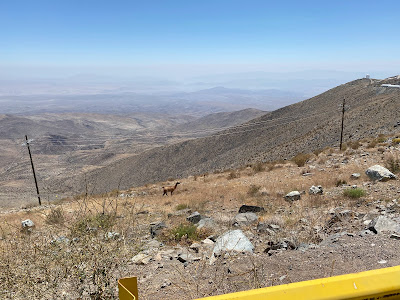As I was making my way to Las Campanas at the start of February, I saw on Twitter that two other women scientists I know, Dr. Helene Le Mevel and Dr. Diana Roman of Carnegie Earth and Planets Division (formerly DTM), were also making their way to Chile. But Helen and Diana aren't studying distant planets around other stars, they are passionate about understanding the only habitable planet we know of -- Earth! I asked Diana if I could interview her for the blog, and she kindly agreed, which is impressive since she was also busy with field work. Below are her responses. I was honestly surprised to recognize similarities between her work and that of astronomers -- Helene and Diana do not have much control over their experiments, they have to take what Earth gives them and come up with creative ways to piece together a complex puzzle with limited data.
I hope you enjoy this slice of science outside astronomy as much as I did! If you have any questions, feel free to comment and I will pass them on to Diana.
1. How would you describe yourself as a scientist?
Broadly speaking, I'm a volcanologist - I'm interested in understanding how magma moves through Earth's crust, accumulates, and eventually erupts. I'm also interested in developing a better understanding of precursory signals that we might be able to measure to improve eruption forecasts. However, most of my research involves the analysis of seismic data - looking at various flavors of tiny earthquakes that result from magma and gas pushing their way through the crust - to me this is an ideal way to understand the processes I study. Almost all of my studies involve other observations - ground deformation, changes in gas emissions, or clues from the chemical composition of erupted materials - I want all the information I can get! So this means I have a wide range of collaborators who bring different expertise and observations to the problem at hand.
2. What are you doing right now (why are you in Chile)?
I'm in Chile to install 10 seismometers and a gas-sensing instrument on Villarrica Volcano, which is just outside Pucon. The project is led by Helene Le Mevel - another volcanologist in my department who is an expert on volcano deformation and on using minute changes in the local gravity field to detect magma and/or gas rising towards the vent. Villarrica is what we consider a 'lab volcano' - since it's always active it's a great place to test out new approaches to monitoring volcanic activity. The main aim of the project is to determine whether continuous monitoring of the gravity field very close to the volcano can help us detect subtle changes in the amount of magma just below the surface - the seismic and gas data I'll be collecting will help give independent constraints on this. The project is very technically challenging - a gravimeter is a delicate (and expensive) piece of equipment, so trying to keep it running on top of a windy, rainy, and active volcano (lots of corrosive gases) is a huge logistical challenge, but I'm confident that if anyone can do it, it will be Helene!
We'll be returning a few times a year over the next two years to check up on our instruments and fix any problems before we remove them from the volcano. We are fortunate to be collaborating with OVDAS (the Observatorio Volcanológico de los Andes del Sur) - the OVDAS scientists have deep knowledge and know-how about this volcano and how to monitor it, and their advice and participation in the project is essential and appreciated.
 |
Hélène Le Mével packs for a year-long study of Villarrica, an active volcano in Chile. Among the standard outdoor equipment are tools for measuring volcanic activity including ten seismometers, five infrasound monitors, one multiGAS machine, one GPS antenna, and two gravimeters. Credit: Carnegie Science | Katy Cain
Read the story behind this photo here. |
3. Why is this work exciting to you?
Villarrica is an extremely active volcano, so I anticipate having lots of seismic signals to analyze. Furthermore, while I'm only leaving my instruments out for a year, the volcano has been monitored and studied for decades, so there is an opportunity to fit my observations of seismicity patterns into a longer time series to understand how the volcano's activity cycles over multi-year periods.
 |
| On the edge of Villarrica! Credit: @HLeMevel on Twitter |
4. What do you hope to learn on this trip, or from the data you collect?
Ultimately, I'm hoping that the data I'm planning to collect will allow me to assess what types of precursors exist at Villarrica and similar volcanoes. Because these volcanoes are continuously active, it's more of a challenge to determine when a major explosion is about to occur, as the levels of seismicity are always high. So I'll be looking for very subtle changes in the seismicity prior to any explosions that occur during our experiment - perhaps differences in the direction of fault-slip that indicate a change in the amount of stress the magma column is producing on the rock, or subtle changes in the frequency content of seismic events that indicate a higher gas flow through the upper parts of the system. The fundamental challenge in volcanology is that we can't plan a precise experiment - we have to work with whatever the volcano gives us. So it's always unclear what exactly we'll be able to learn until we see how the activity evolves once we have our instruments out, or what we'll learn.
5. What is the most fun aspect of your work, overall and/or on this specific trip?
My work takes me all over the world - I've worked in Alaska and Hawaii, but also Iceland, Italy, Nicaragua, Mexico, and now Chile. I love these opportunities to travel and spend time in different places. Doing fieldwork in a country is a great way to learn about it - we work closely with Chilean scientists, and we get to see a lot of 'normal life' in Chile - very different than being a tourist. I love meeting people during my work - not only the local scientists, but the people who live on and around the volcanoes I study. Hearing their stories and their perspectives about the volcano is always fascinating!
6. Anything else you'd like to add?
There are eight of us on this trip - myself, our project leader Helene, Kathleen (a postdoc at Carnegie), Dani (a PhD candidate at Drexel University), John West (an independent scientist from New Mexico), Giovanni Pineda and Patricio Mardones (engineering students from the local university), and Loreto Cordova (a geodesist from OVDAS) - so our team is more than half women!
 |
| Some of the team members on this expedition. Credit: @HLeMevel on Twitter |










.jpg)
.jpg)
.jpg)
.jpg)












